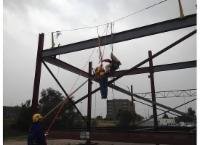Three GREAT classes being offered for this week!! Sign up today
RESCUE Basics -4 hour-Hands on!
class set up for this Friday September 14th
@ 7:30-11:30 $200
Fall Protection Awareness- 4 hour
class scheduled for this Thursday September 13th
@ 12:00-4:00 $95
(Combine Rescue at heights and fall protection awareness for just $275)
Confined Space- 4 hour
class set up for this Thursday September 13th
@ 7:30-11:30 $155
RESCUE AT HEIGHTS Plan:
Do you have a developed site-specific rescue plan for working at heights?
1.0 PURPOSE The purpose of this rescue class is to help create a guideline for responding to falls from height. Rescue plans are intended to reduce risks to an employee’s health after a fall arrest event. The rescue plan should also minimize the amount of at-risk behavior of the rescuer during the rescue attempt, and help to ensure that the rescue is conducted promptly in a safe and professional manner.
2.0 APPLICATION 2.1 This rescue plan applies to all locations where personnel are employed to work at height. 2.2 The requirements of this rescue plan must be observed by all personnel involved in working at heights. 2.3 This rescue plan must be reviewed or included in any job safety analysis or pre-task planning for activities that require working at heights.
3.0 DEFINITIONS
3.1 RESCUE PLAN: A strategy or procedure, planned in advance, to safely retrieve a person who has fallen from an elevated work surface and is suspended in a full body harness. This includes self-rescue or mechanically aided rescue.
3.2 SELF RESCUE: An act or instance of an employee using his fall protection equipment to rescue him or herself.
3.3 MECHANICALLY AIDED RESCUE: A strategy or procedure, planned in advance, to safely retrieve a person who has fallen from an elevated work surface using mechanical means.
3.4 SUSPENSION TRAUMA: A serious medical condition that can lead to unconsciousness, injury or death, which can occur when a worker is suspended in a harness for too long after a fall.
3.5 PROMPT RESCUE: The recommended goal for rescue subject contact is less than six minutes, per ANSI Z359.2-6.1.
HANDS on Training Class This Friday!!!! Sign up- it is fun and a great way to figure out what rescue plan works for your job exposures.
FALL PROTECTION PROGRAM
4.0 RESPONSIBILITIES
4.1 EMPLOYEES: • Must be trained in and familiar with the Fall Protection Program. • Must understand and be able to evaluate the risks associated with working at heights. • Must be trained and competent in the use of fall protection equipment prior to conducting work at heights. • Must report unsafe conditions or behaviors to the Person-In-Charge. • Must be familiar with and understand the company’s rescue plan to provide prompt rescue in the event of an arrested fall event.
4.2 AUTHORIZED RESCUER: • Must be trained by a competent rescuer trainer before being exposed to a fall hazard or potential rescue application. • Must be re-trained when the nature of the work, workplace, or methods of control or rescue change to an extent that prior training is no longer adequate. • Must be trained on how to inspect, anchor, assemble and use the fall protection and rescue equipment used in locations where employees work. Training must include physical demonstrations by trainees. • Training must include at least the following: o Fall hazard recognition; o Fall hazard elimination and control methods; o Applicable fall protection and rescue regulations; o How to use written fall protection and rescue procedures; o Inspection of equipment components and systems before use. • Refresher training must occur at least every two years for the authorized rescuer to stay current with fall protection and rescue educational requirements per ANSI. • Must be evaluated by a competent rescuer or competent rescuer trainer at least annually to ensure competency of the duties assigned. This evaluation must include both a written examination and a physical demonstration of usage of all equipment the person is authorized to operate.
Confined Space
5.0 RESPONSIBILITIES OSHA's rule for confined spaces (construction) covers employers with employees working in confined spaces on construction work sites with one or more confined spaces. Confined space activities beyond maintenance such as construction, alteration, and/or repair, including painting and decorating, are covered under the construction rule. Sites include buildings, residences, highways, bridges, tunnels, utility lines, and other types of projects. Also potentially affected are general contractors, as well as specialty-trade construction contractors and employers engaged in some types of residential construction work.
5.1 EMPLOYEES: • The rule includes requirements for training, identification and assessment of confined spaces, hazard analysis, entering, working, exiting, and rescue for confined spaces containing a variety of different hazards.
The U.S. Occupational Safety and Health Administration’s (OSHA) confined spaces in construction standards (29 CFR 1926, Subpart AA) cover any space that meets the following three criteria:
- Is large enough for a worker to enter;
- Has limited means of entry or exit; and
- Is not designed for continuous occupancy.
The rule includes requirements for training, identification and assessment of confined spaces, hazard analysis, entering, working, exiting, and rescue for confined spaces containing a variety of hazards.
Sign up today!!















